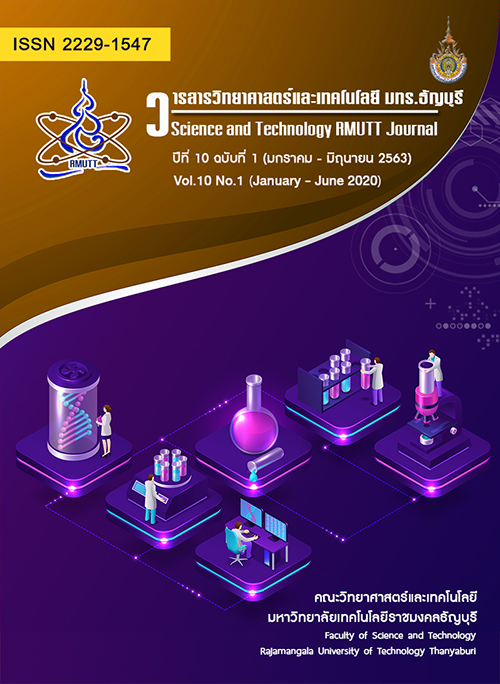Oxidative Addition of bromobenzene on Au20 and Au10Pd10: Evidenced by Density Functional Theory Calculations
Main Article Content
Abstract
The unusual catalytic activity of bimetallic Au/Pd alloy nanocluster for Ullmann coupling reaction of bromobenzene has been theoretically investigated by mean of DFT with M06 functional. It is found that two factors governing the catalytic activity of Au/Pd towards bromobenzene are the stability of dissociative chemisorption in the oxidative addition step and leaching of Pd during the progress of the reaction. The differences in catalytic activity between bimetallic Au/Pd and monometallic Au are also discussed.
Article Details
References
Ullmann F. and Bielecki J. Ueber Synthesen in der Biphenylreihe. Chem. Ber. 1901. 34: 2174-2185. b) Ullmann F. Catalytic CC, CN, and CO Ullmann-Type Coupling Reactions: Copper Makes a Difference. Ber. Dtsch. Chem. Ges. 1903. 36: 2382-2384. c) Goldberg I. Ueber Phenylirungen bei Gegenwart von Kupfer als Katalysator. Ber. Dtsch. Chem. Ges. 1906. 39: 1691-1692.
Hassan J., Sevignon M., Gozzi C., E. and Lemaire M. Aryl-Aryl Bond Formation One Century after the Discovery of the Ullmann Reaction. Chem. Rev. 2002. 102: 1359–1470.
Sainsbury M. Modern methods of aryl-aryl bond formation. Tetrahedron 1980. 36: 3327-3359.
Bringmann G., Walter R. and Weirich R. Der gezielte Aufbau von Biarylverbindungen: Moderne Konzepte and Strategien. Angew. Chem. 1990. 102: 1006-1019.
Sperotto E., G. P. van Klink M., van Koten G. and de Vries J. G. The mechanism of the modified Ullmann reaction. Dalton Trans. 2010. 39: 10338-10351.
Dhital R. N., Kamonsatikul C., Somsook E., Bobuatong K., Ehara M., Karanjit S. and Sakurai H. Low-Temperature Carbon–Chlorine Bond Activation by Bimetallic Gold/Palladium Alloy Nanoclusters: An Application to Ullmann Coupling. J. Am. Chem. Soc. 2012. 134: 20250-20253.
Dhital R. N., Kamonsatikul C., Somsook E., Sato Y. and Sakurai H. Aryl iodides as strong inhibitors in gold and gold-based bimetallic quasi-homogeneous catalysis. Chem. Commun. 2013. 49: 2542-2544.
Cleri F. and Rosato V. Tight-binding potentials for transition metals and alloys. Phys, Rev. B 1993. 48: 22.
Johnston R. L. Evolving better nanoparticles: Genetic algorithms for optimising cluster geometries. Dalton Trans. 2003. 4193-4207.
Pittaway F., Paz-Borbo´n L. O., Johnston R. L., Arslan H., Ferrando R., Mottet C., Barcaro G. and Fortunelli A. Theoretical Studies of Palladium-Gold Nanoclusters: Pd-Au Clusters with up to 50 Atoms. J. Phys. Chem. C. 2009. 113: 9141-9152.
Zhao Y. and Truhlar D. The M06 suite of density functionals for main group thermochemistry, thermochemical kinetics, noncovalent interactions, excited states, and transition elements: two new functionals and systematic testing of four M06-class functionals and 12 other functionals. Theor. Chem. Acc. 2008. 120: 215-241.
Gaussian 09, Revision B.01, Frisch M. J., Trucks G. W., Schlegel H. B., Scuseria G. E., Robb M. A., Cheeseman J. R., Scalmani G., Barone V., Mennucci B., Petersson G. A., Nakatsuji H., Caricato M., Li X., Hratchian H. P., Izmaylov A. F., Bloino J., Zheng G., Sonnenberg J. L., Hada M., Ehara M., Toyota K., Fukuda R., Hasegawa J., Ishida M., Nakajima T., Honda Y., Kitao O., Nakai H., Vreven T., Montgomery J. A. Jr., Peralta J. E., Ogliaro F., Bearpark M., Heyd J. J., Brothers E., Kudin K. N., Staroverov V. N., Kobayashi R., Normand J., Raghavachari K., Rendell A., Burant J. C., Iyengar S. S., Tomasi J., Cossi M., Rega N., Millam J. M., Klene M., Knox J. E., Cross J. B., Bakken V., Adamo C., Jaramillo J., Gomperts R., Stratmann R. E., Yazyev O., Austin A. J., Cammi R., Pomelli C., Ochterski J. W., Martin R. L., Morokuma K., Zakrzewski V. G., Voth G. A., Salvador P., Dannenberg J. J., Dapprich S., Daniels A. D., Farkas Ö., Foresman J. B., Ortiz J. V., Cioslowski J. and Fox D. J. Gaussian, Inc., Wallingford CT, 2010.
Mejía-Rosales S. J., Fernández-Navarro C., Pérez-Tijerina C. E., Blom D. A., Allard L. F. and José-Yacamán M. On the Structure of Au/Pd Bimetallic Nanoparticles. J. Phys. Chem. C. 2007. 111: 1256-1260.
Luo K., Wei T., Yi C. W., Axnanda S. and Goodman D. W. J. Preparation and Characterization of Silica Supported Au−Pd Model Catalysts. J. Phys. Chem. B. 2005. 109: 23517-23522.
Bobuatong K., Karanjit S., Fukuda R., Ehara M. and Sakurai H. Aerobic oxidation of methanol to formic acid on Au20−: a theoretical study on the reaction mechanism. Phys. Chem. Chem. Phys. 2012. 14: 3103- 3111.
Marenich A. V., Cramer C. J. and Truhlar D. G. Universal Solvation Model Based on Solute Electron Density and on a Continuum Model of the Solvent Defined by the Bulk Dielectric Constant and Atomic Surface Tensions. J. Phys. Chem. B. 2009. 113: 6378-6396.
Dhital R. N. and Sakurai H. Anomalous Efficacy of Bimetallic Au/Pd Nanoclusters in C–Cl Bond Activation and Formal Metathesis-type C–B Bond Activation at Room Temperature. Chem. Lett. 2012. 41: 630-632.
Feller D. The role of databases in support of computational chemistry calculations. J. Comp. Chem. 1996. 17: 1571-1586.
Marenich A. V., Cramer C. J., and Truhlar D. G., Universal Solvation Model Based on Solute Electron Density and on a Continuum Model of the Solvent Defined by the Bulk Dielectric Constant and Atomic Surface Tensions. J. Phys. Chem. B 2009. 113: 6378-6396.
Peng C., and Schlegel H. B., Combining Synchronous Transit and Quasi-Newton Methods for Finding Transition States. Israel J. Chem., 33 1993. 449-54.






